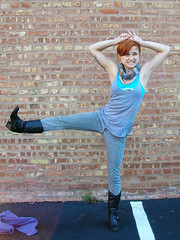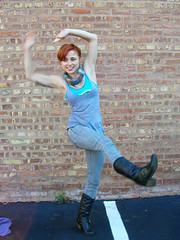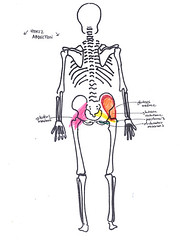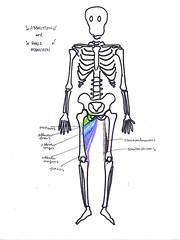Horizontal abduction and adduction of the leg at the hip isn't covered in the book, why not! It's so great.
What movements happen at this joint?
So it may look like Biggie is abducting her leg in the left pic and flexing her leg in the right pic, except for the telltale blur on the return. Instead she first flexes her leg and then abducts her leg in a horizontal position, which is horizontal abduction. Then she adducts her leg, still in a horizontal position, for horizontal adduction. Not the easiest thing to do standing, which is to say standing on one leg. It takes strength! Balance! Flexibility! If you are lacking in any of these and can't do this without falling over, you can bend your leg at the knee to make your leg weigh less.
Like your shoulder, your hip is a highly mobile ball and socket joint and can "rotate" through flexion, horizontal abduction, abduction, horizontal (backwards) adduction, (backwards) adduction, and extension, which is to say circumduction.
What muscles make these movements happen?
The muscles that horizontally abduct your leg at the hip are your gluteus maximus, gluteus medius, gluteus minimus, piriformis, and obdurator externus, which is to say your glutes and uppermost external rotators. The muscles that horizontally adduct your leg at the hip are your pectineus, adductor brevis, adductor longus, adductor magnus, and gracilis, which is to say your adductors. I am not sure about semimembranosus and semitendinosus, which are involved in adduction according to the book; but my info for horizontal abduction and adduction is pieced together from the internet, so take with salt.
What exercises make these muscles work?
Exercises for the external rotators will be given in the next post.



